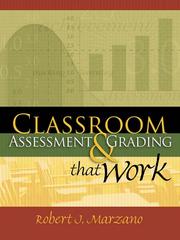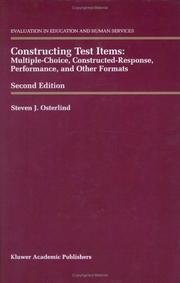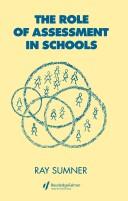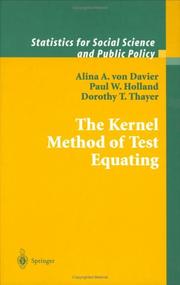| Listing 1 - 10 of 17 | << page >> |
Sort by
|
Book
ISBN: 0792390121 Year: 1989 Publisher: Boston Kluwer
Abstract | Keywords | Export | Availability | Bookmark
 Loading...
Loading...Choose an application
- Reference Manager
- EndNote
- RefWorks (Direct export to RefWorks)
Examinations --- #PEDA *015.35 --- #PEDA *1.26 --- Test construction --- Test design --- Design and construction --- Didactic evaluation

ISBN: 1416605908 1280928573 9786610928576 1416605886 9781416605881 9781416605904 Year: 2006 Publisher: Alexandria, VA : Association for Supervision and Curriculum Development,
Abstract | Keywords | Export | Availability | Bookmark
 Loading...
Loading...Choose an application
- Reference Manager
- EndNote
- RefWorks (Direct export to RefWorks)
Robert J. Marzano distills 35 years of research to bring you expert advice on the best practices for assessing and grading the work done by today's students.
Educational tests and measurements --- Examinations --- Grading and marking (Students) --- Test construction --- Test design --- Design and construction.
Book
ISBN: 0675088453 Year: 1974 Publisher: Columbus (Ohio) : Merrill,
Abstract | Keywords | Export | Availability | Bookmark
 Loading...
Loading...Choose an application
- Reference Manager
- EndNote
- RefWorks (Direct export to RefWorks)
Examinations --- -Competitive examinations --- Tests --- Questions and answers --- Educational tests and measurements --- Design and construction --- Design and construction. --- -Design and construction --- Test construction --- Test design

ISBN: 9780792380771 0792380770 9780306475351 9786610200221 1280200227 0306475359 Year: 1998 Publisher: Boston : Kluwer Academic Publishers,
Abstract | Keywords | Export | Availability | Bookmark
 Loading...
Loading...Choose an application
- Reference Manager
- EndNote
- RefWorks (Direct export to RefWorks)
Constructing test items for standardized tests of achievement, ability, and aptitude is a task of enormous importance. The interpretability of a test's scores flows directly from the quality of its items and exercises. Concomitant with score interpretability is the notion that including only carefully crafted items on a test is the primary method by which the skilled test developer reduces unwanted error variance, or errors of measurement, and thereby increases a test score's reliability. The aim of this entire book is to increase the test constructor's awareness of this source of measurement error, and then to describe methods for identifying and minimizing it during item construction and later review. Persons involved in assessment are keenly aware of the increased attention given to alternative formats for test items in recent years. Yet, in many writers' zeal to be `curriculum-relevant' or `authentic' or `realistic', the items are often developed seemingly without conscious thought to the interpretations that may be garnered from them. This book argues that the format for such alternative items and exercises also requires rigor in their construction and even offers some solutions, as one chapter is devoted to these alternative formats. This book addresses major issues in constructing test items by focusing on four ideas. First, it describes the characteristics and functions of test items. A second feature of this book is the presentation of editorial guidelines for writing test items in all of the commonly used item formats, including constructed-response formats and performance tests. A third aspect of this book is the presentation of methods for determining the quality of test items. Finally, this book presents a compendium of important issues about test items, including procedures for ordering items in a test, ethical and legal concerns over using copyrighted test items, item scoring schemes, computer-generated items and more.
Examinations --- Examens --- Design and construction. --- Elaboration --- Psychodiagnostiek --- handboeken en inleidingen --- Examinations -- Design and construction. --- Education --- Social Sciences --- Theory & Practice of Education --- Design and construction --- handboeken en inleidingen. --- Education. --- Assessment. --- Assessment, Testing and Evaluation. --- Educational tests and measuremen. --- Educational tests and measurements. --- Test construction --- Test design
Book
ISBN: 9811004323 981100434X Year: 2016 Publisher: Singapore : Springer Singapore : Imprint: Springer,
Abstract | Keywords | Export | Availability | Bookmark
 Loading...
Loading...Choose an application
- Reference Manager
- EndNote
- RefWorks (Direct export to RefWorks)
This book discusses Hong Kong’s use of onscreen marking (OSM) in public examinations. Given that Hong Kong leads the way in OSM innovation, this book has arisen from a recognised need to provide a comprehensive, coherent account of the findings of various separate but linked validation studies of onscreen public examinations in Hong Kong. The authors discuss their experience of the validation process, demonstrating how high-stakes innovation should be fully validated by a series of research studies in order to satisfy key stakeholders.
Education. --- Assessment. --- Assessment, Testing and Evaluation. --- Examinations --- Educational tests and measurements --- Design and construction. --- Educational assessment --- Educational measurements --- Mental tests --- Tests and measurements in education --- Test construction --- Test design --- Psychological tests for children --- Psychometrics --- Students --- Psychological tests --- Rating of --- Educational tests and measuremen.
Book
ISBN: 9460914772 9460914780 9786613695628 1280785233 Year: 2011 Publisher: Rotterdam : Sense Publishers,
Abstract | Keywords | Export | Availability | Bookmark
 Loading...
Loading...Choose an application
- Reference Manager
- EndNote
- RefWorks (Direct export to RefWorks)
Some ten years from today, American schools have tried every possible education fad. Common national standards, year-round schools, takeover of school boards, and even the super-qualified teacher program have failed to improve low U.S. achievement on international assessments. That all changes when Grant and Jennifer Wilson, both Stanford Ph.D. graduates, create what they believe are the perfect tests. The Venus Assessment System, the first national tests in U.S. history, flip American education on its ear, making U.S. students number one in the world in math and science. But then Jennifer Wilson discovers a secret list of names, students who are exceptions to the high-stakes consequences of the test. So secret that some people are willing to kill for it. With a tremendous blending of suspense tied to realistic future events, The Perfect Test will appeal to readers of all types, from educators and parents to simply anyone who loves a great, page-turner. As writer Paul Baker from the University of Wisconsin says, “Like The Name of the Rose and The Da Vinci Code, this story grabs the reader and won’t let go.” “At a moment of national testing madness, the [Perfect Test] story-line was both fun and gripping. And like all good mystery/science fiction, educational too. I won’t give away the ending.” Deborah Meier, New York University: teacher, writer, and public activist. Author of In Schools We Trust and Many Children Left Behind “Ron Dietel’s The Perfect Test reads like a Stephen King novel. A perfect blend of mystery, action and constant surprises, nicely intertwined in a future world of national high-stakes tests. You won’t be able to stop reading it.” Jim Kohlmoos, President, Knowledge Alliance: Research to Action in Education “Ready for a break, for a romp? Pick up Ronald Dietel’s biting spoof, The Perfect Test. It’s a dystopian vision of a world gone crazy, a science fiction portrait of the future that often comes wickedly close to where we are now. John Merrow, President, Learning Matters.
Educational evaluation. --- Examinations -- Design and construction. --- Examinations. --- Education --- Social Sciences --- Education, Special Topics --- Theory & Practice of Education --- Examinations --- Design and construction. --- Test construction --- Test design --- Educational assessment --- Educational program evaluation --- Evaluation research in education --- Instructional systems analysis --- Program evaluation in education --- Self-evaluation in education --- Education. --- Assessment. --- Assessment, Testing and Evaluation. --- Evaluation --- Educational tests and measuremen.

ISBN: 1135799776 0585452954 1280405333 9786610405336 0203480333 9780203480335 9780585452951 6610405336 9780700512638 0700512632 0700512632 9781135799724 9781135799762 9781135799779 9781138421462 1135799768 Year: 1991 Publisher: Windsor, Berkshire, England Neer-Nelson
Abstract | Keywords | Export | Availability | Bookmark
 Loading...
Loading...Choose an application
- Reference Manager
- EndNote
- RefWorks (Direct export to RefWorks)
The Role of Assessment in Schools looks at the conceptual aspects of tests and testing and also gives practical guidelines on how to use tests to their best effect. It provides a wide-ranging discussion of the development of tests, the types and scope of tests, their application and interpretation, and answers questions such as: Who wants testing? Is the test appropriate? Is the test biased? Are the results consistent?
Educational tests and measurements. --- Examinations --- Interpretation of examinations --- Test interpretation --- Test results --- Test construction --- Test design --- Educational assessment --- Educational measurements --- Mental tests --- Tests and measurements in education --- Psychological tests for children --- Psychometrics --- Students --- Psychological tests --- Design and construction. --- Interpretation. --- Validity --- Rating of
Book
ISBN: 9781641139526 9781641139519 9781641139533 1641139536 1641139536 1641139528 164113951X Year: 2020 Publisher: Charlotte, NC
Abstract | Keywords | Export | Availability | Bookmark
 Loading...
Loading...Choose an application
- Reference Manager
- EndNote
- RefWorks (Direct export to RefWorks)
"The general theme of this book is to present the applications of artificial intelligence (AI) in test development. In particular, this book includes research and successful examples of using AI technology in automated item generation, automated test assembly, automated scoring, and computerized adaptive testing. By utilizing artificial intelligence, the efficiency of item development, test form construction, test delivery, and scoring could be dramatically increased. Chapters on automated item generation offer different perspectives related to generating a large number of items with controlled psychometric properties including the latest development of using machine learning methods. Automated scoring is illustrated for different types of assessments such as speaking and writing from both methodological aspects and practical considerations. Further, automated test assembly is elaborated for the conventional linear tests from both classical test theory and item response theory perspectives. Item pool design and assembly for the linear-on-the-fly tests elaborates more complications in practice when test security is a big concern. Finally, several chapters focus on computerized adaptive testing (CAT) at either item or module levels. CAT is further illustrated as an effective approach to increasing test-takers' engagement in testing. In summary, the book includes both theoretical, methodological, and applied research and practices that serve as the foundation for future development. These chapters provide illustrations of efforts to automate the process of test development. While some of these automation processes have become common practices such as automated test assembly, automated scoring, and computerized adaptive testing, some others such as automated item generation calls for more research and exploration. When new AI methods are emerging and evolving, it is expected that researchers can expand and improve the methods for automating different steps in test development to enhance the automation features and practitioners can adopt quality automation procedures to improve assessment practices" --
Artificial intelligence. Robotics. Simulation. Graphics --- Mathematical linguistics --- Examinations --- Educational tests and measurements --- Artificial intelligence --- Computer adaptive testing. --- Design and construction. --- Data processing. --- Educational applications. --- Adaptive testing, Computer --- CAT (Computer adaptive testing) --- Computer adaptive tests --- Computerized adaptive testing --- Ability --- Competency-based educational tests --- Education --- Test construction --- Test design --- Testing --- Data processing
Book
ISBN: 9026506538 9789026506536 Year: 1986 Volume: 3 Publisher: Lisse Swets en Zeitlinger
Abstract | Keywords | Export | Availability | Bookmark
 Loading...
Loading...Choose an application
- Reference Manager
- EndNote
- RefWorks (Direct export to RefWorks)
Teaching --- Service industry --- Examinations --- Design and construction --- 371.26 --- -Examinations --- -Competitive examinations --- Tests --- Questions and answers --- Educational tests and measurements --- Beoordeling van leerlingen. Schoolprestaties. Leerprestaties. Onderwijstaxonomie --- Pedagogiek en onderwijskunde --- Design and construction. --- didactische principes --- -Beoordeling van leerlingen. Schoolprestaties. Leerprestaties. Onderwijstaxonomie --- didactische principes. --- 371.26 Beoordeling van leerlingen. Schoolprestaties. Leerprestaties. Onderwijstaxonomie --- -371.26 Beoordeling van leerlingen. Schoolprestaties. Leerprestaties. Onderwijstaxonomie --- Competitive examinations --- Didactische principes. --- Test construction --- Test design --- Examinations - Design and construction --- Examinations - Netherlands - Design and construction

ISBN: 1280189037 9786610189038 0387217193 0387019855 Year: 2004 Publisher: New York, New York : Springer,
Abstract | Keywords | Export | Availability | Bookmark
 Loading...
Loading...Choose an application
- Reference Manager
- EndNote
- RefWorks (Direct export to RefWorks)
Kernel Equating (KE) is a powerful, modern and unified approach to test equating. It is based on a flexible family of equipercentile-like equating functions and contains the linear equating function as a special case. Any equipercentile equating method has five steps or parts. They are: 1) pre-smoothing; 2) estimation of the score-probabilities on the target population; 3) continuization; 4) computing and diagnosing the equating function; 5) computing the standard error of equating and related accuracy measures. KE brings these steps together in an organized whole rather than treating them as disparate problems. KE exploits pre-smoothing by fitting log-linear models to score data, and incorporates it into step 5) above. KE provides new tools for diagnosing a given equating function, and for comparing two or more equating functions in order to choose between them. In this book, KE is applied to the four major equating designs and to both Chain Equating and Post-Stratification Equating for the Non-Equivalent groups with Anchor Test Design. This book will be an important reference for several groups: (a) Statisticians and others interested in the theory behind equating methods and the use of model-based statistical methods for data smoothing in applied work; (b) Practitioners who need to equate tests—including those with these responsibilities in testing companies, state testing agencies and school districts; and (c) Instructors in psychometric and measurement programs. The authors assume some familiarity with linear and equipercentile test equating, and with matrix algebra. Alina von Davier is an Associate Research Scientist in the Center for Statistical Theory and Practice, at Educational Testing Service. She has been a research collaborator at the Universities of Trier, Magdeburg, and Kiel, an assistant professor at the Politechnical University of Bucharest and a research scientist at the Institute for Psychology in Bucharest. Paul Holland holds the Frederic M. Lord Chair in Measurement and Statistics at Educational Testing Service. He held faculty positions in the Graduate School of Education, University of California, Berkeley and the Harvard Department of Statistics. He is a Fellow of the American Statistical Association, the Institute of Mathematical Statistics, and the American Association for the Advancement of Science. He is an elected Member of the International Statistical Institute and a past president of the Psychometric society. He was awarded the (AERA/ACT) E. F. Lindquist Award, in 2000, and was designated a National Associate of the National Academies of Science in 2002. Dorothy Thayer currently is a consultant in the Center of Statistical Theory and Practice, at Educational Testing Service. Her research interests include computational and statistical methodology, empirical Bayes techniques, missing data procedures and exploratory data analysis techniques.
Examinations --- Educational tests and measurements --- Scoring. --- Interpretation. --- Design and construction. --- Standards. --- Econometrics. --- Statistics. --- Educational tests and measuremen. --- Psychometrics. --- Statistics for Social Sciences, Humanities, Law. --- Assessment, Testing and Evaluation. --- Statistics . --- Assessment. --- Measurement, Mental --- Measurement, Psychological --- Psychological measurement --- Psychological scaling --- Psychological statistics --- Psychology --- Psychometry (Psychophysics) --- Scaling, Psychological --- Psychological tests --- Scaling (Social sciences) --- Statistical analysis --- Statistical data --- Statistical methods --- Statistical science --- Mathematics --- Econometrics --- Economics, Mathematical --- Statistics --- Measurement --- Scaling --- Methodology --- Educational assessment --- Educational measurements --- Mental tests --- Tests and measurements in education --- Psychological tests for children --- Psychometrics --- Students --- Test construction --- Test design --- Interpretation of examinations --- Test interpretation --- Test results --- Remote scoring of examinations --- Scoring of examinations --- Self-scoring of examinations --- Test scoring --- Rating of --- Validity
| Listing 1 - 10 of 17 | << page >> |
Sort by
|

 Search
Search Feedback
Feedback About UniCat
About UniCat  Help
Help News
News